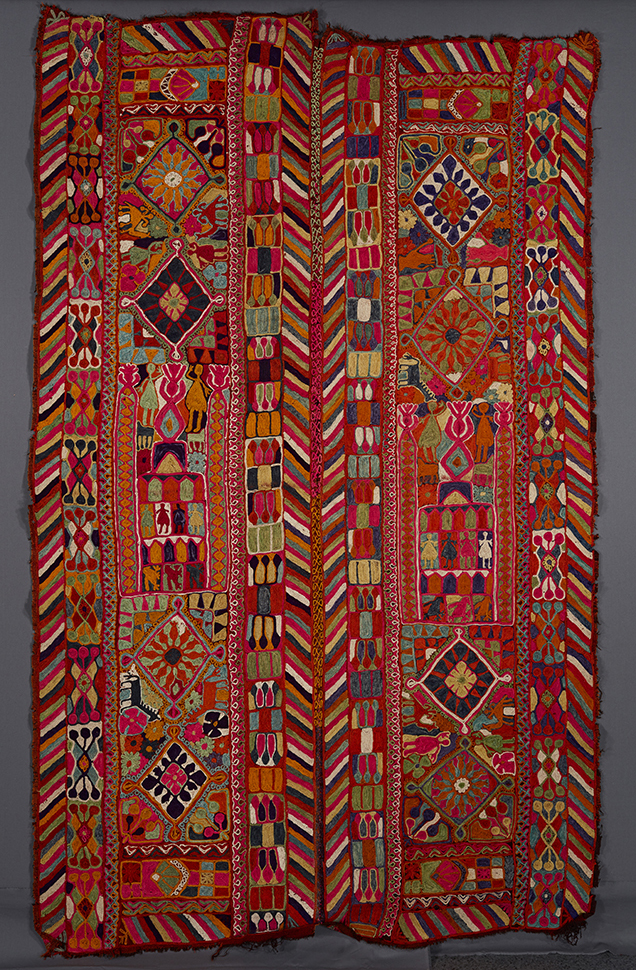The Wedding blankets
Initially, mainly young unmarried women embroidered the blankets by hand for their bridal chests. This is probably the main reason why the textiles are referred to by the termas wedding blankets. In some cases, mothers also made these kinds of embroidered blankets for their sons before their wedding. The Ma’dan purchased the fabrics from the Bedouins who passed by their villages, then mainly young unmarried in the Ma’dan community embroidered the blankets by hand. The embroidery could vary in the density of patterns, from being light to more elaborate and heavy. The heavier the embroidery, the more precious the blankets. The latter ones were seen as the most valuable wedding blankets. The young women with the best skills in embroidery were highly esteemed and respected members of the community.
Techniques of weaving and embroidery
The wedding blankets are made from a twill-bound reddish-brown woolen fabric, on which the women embroidered their various designs. The women used an embroidery technique chaining stitches with a crochet hook. Most of the blankets in the museum’s ethnographic collection are elaborately embroidered, to the extent that the textile itself is hidden by colorful embroidery. Still, there are a few exceptions where the relative scarcity of embroidery appears to be deliberate in the sense that the background fabrics have been incorporated into the image as part of the decorative expression. The width of the blankets was determined by the size of the loom they used for weaving them, which means that the full blankets are made from two narrower lengths of fabric of the same size. The women then embroidered these lengths of fabric before sewing them together along the ends of the fabric pieces in order to create one large blanket, hiding the seams with the embroidery. As mentioned, local conventions dictated that only women were supposed to make the embroidery on the blankets. However, both women and men could do the hand spinning of wool. This difference in labor and skills is linked to a more comprehensive division of labor between men and women practiced by the Ma’dan community.

Motifs
The blankets all have an embroidered border on each of the four edges, which are divided into large squares or panels. The motifs embroidered on the blankets show different kinds of animals such as camels, dogs, and horses, but also fish, birds, and insects. Human figures of both genders are also represented on some of the blankets. A frequent motif on several of the blankets are diamond-shaped figures and flowers. Finally, a few blankets are decorated with either a house (mudhif) or a mosque. The design and thus, embroidery seem to capture abstract adaptations of the Ma’dan environmental surroundings. It is plausible that the varying combination of motifs on different blankets follows the artists’ preference as well as their individual interpretation and envisioning of the same motifs according to inspiration and aesthetic preference.

The Ma’dan people of southern Iraq
Initially, the Ma’dan people lived on platforms or islands located directly on the marshes in southern Iraq, between the rivers Euphrates and Tigris in what used to be ancient Babylon. Until the late 1960s, the Ma’dan people lived rather isolated from the rest of Iraq. Their contact with the outside world happened mainly through the Bedouins, nomadic people, occupying the edges of the marshes during the autumn and parts of the winter, and with Kurds in nearby villages, from whom the Ma’dan also got the textiles used to produce the wedding blankets. Later on, the Ma’dan could even purchase the hand-woven textile from which they created their embroidered blankets, from the Bedouins and Kurds who lived in the nearby market towns. During later years, in the 1980s, embroidered wedding blankets were also traded at the local markets.
State interventions transforming the ecosystem of the marshes and Ma’dan livelihood
During the late 1980s the Iraqi government, then led by Saddam Hussein, approved developmental plans that eventually dried up the marshes. The official argument for the elimination of the mashes was firstly, the mashes’ role as breeding ground for mosquitoes and secondly, to transform marshes’ lack of apparent economic value into agricultural land. Politically, it has been suggested that the main reason was to force the Mash Arabs and thus, the Ma’dan to leave the area. The result of the drainage was a conversion from a former wetland to a desert. Consequently, this led to the displacement and thus dispersal of about 200 000 of the Ma’dan community whose livelihood depended on the mashes. Displaced to areas adjacent to the drained mashes and in towns and camps elsewhere in Iraq, the Ma’dan abandoned their traditional lifestyle for other occupations, including conventional agriculture.
In 2003, the dikes were removed, and the water could again flow freely. Still, due to the complete destruction of the ecosystem in the area and adjustment to a different form of life, it seems unlikely that the Ma’dan could resume their previous livelihood in the region that they used to consider their homeland.

Literature:
Al-mudaffar Fawzi, Nadia, Kelly P. Goodwin, Bayan A. Mahdi & Michelle L. Stevens. 2016. «Effects of Mesopotamian March (Iraq) Dessication on the Cultural Knowledge and Livelihood of Marsh Arab Women, Ecosystem Health and Sustainability”, i Ecosystem Health and Sustainability, Nr 2 (Vol 3), pp. 1-16.
Ochsenschlager, Edward L. 2004. Iraq's Marsh Arabs in the Garden of Eden. University of Pennsylvania Press; Pennsylvania.
https://en.wikipedia.org/wiki/Marsh_Arabs (read 23. 04. 2022)























Log in to comment
Not UiO or Feide account?
Create a WebID account to comment